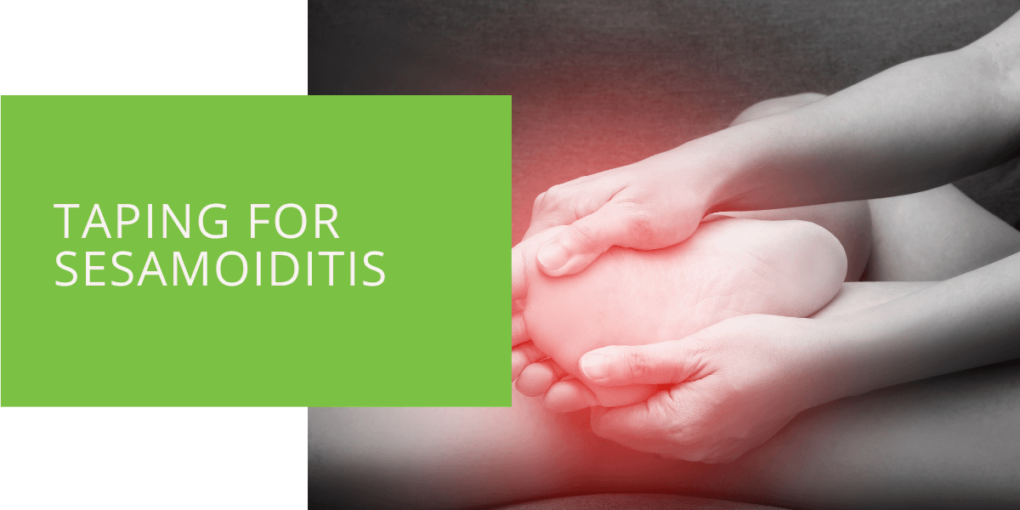Taping for Sesamoiditis
Sesamoiditis, a painful condition characterized by inflammation in the sesamoid bones, can significantly impact one's ability to walk and carry out daily activities. If you're experiencing big toe joint pain or discomfort in the bottom of your big toe, taping may offer relief and support during the healing process. In this comprehensive guide, we explore the role of taping in managing sesamoiditis, along with other essential treatment approaches, exercises, and preventive measures to ensure long-term foot health. Discover how taping techniques and supportive measures can alleviate pain, reduce inflammation, and promote healing, allowing you to regain mobility and enjoy life to the fullest.
The Role of Taping in Sesamoiditis Management
Taping is a valuable tool in managing sesamoiditis, as it helps reduce pressure on the sesamoid bones and stabilizes the big toe joint. By providing support and cushioning, taping assists in pain relief, minimizes inflammation, and promotes healing. It is a non-invasive, cost-effective approach that can be easily incorporated into a comprehensive treatment plan.
Tools and Techniques for Sesamoiditis Taping
Regarding sesamoiditis taping, various tools and techniques are available to alleviate pain and provide support. The type of tape used may vary, but commonly utilized options include athletic or kinesiology tape. To achieve optimal results, it is essential to follow proper taping techniques, which involve securing the tape around the big toe joint, providing stability, and reducing excessive movement.
Understanding the Difference: Sesamoiditis vs. Sesamoid Fracture
Differentiating between sesamoiditis and a sesamoid fracture is crucial for appropriate treatment. While sesamoiditis refers to inflammation of the sesamoid bones, a sesamoid fracture involves a break or crack in these bones. Proper diagnosis, which may involve imaging tests like X-rays or MRIs, is essential to determine the correct course of action. It is crucial to consult with a podiatrist or foot and ankle specialist to assess the condition and develop an appropriate treatment plan accurately.

Additional Support: Pads, Orthotics, and Footwear
In addition to taping, other support options can aid in managing sesamoiditis. Pads and orthotic devices, such as insoles or custom orthotics, offer cushioning, reduce pressure on the sesamoid bones, and provide arch support. These aids help distribute weight evenly and alleviate discomfort during activities. Choosing proper footwear, such as shoes with a wide toe box and adequate cushioning, is also important to minimize stress on the foot.
Rehabilitation Exercises and Stretching
Exercise and stretching play a vital role in sesamoiditis's healing and rehabilitation process. Gentle exercises help strengthen the foot muscles and improve flexibility, while targeted stretches can alleviate tension and reduce strain on the affected area. It is advisable to consult with a physical therapist or podiatrist who can guide you in designing an individualized exercise program to promote healing and prevent future injuries.
Other Pain Relief Strategies
In addition to taping, several pain relief strategies can complement sesamoiditis treatment. Massage therapy, using techniques such as rolling a foam roller under the foot, can help alleviate pain and reduce inflammation. Applying ice packs to the affected area can reduce swelling and provide temporary relief. Healthcare professionals may also recommend over-the-counter nonsteroidal anti-inflammatory drugs (NSAIDs) for short-term pain management.
Preventive Measures and Long-Term Foot Health
Preventing sesamoiditis and maintaining long-term foot health involves adopting certain preventive measures. This includes wearing appropriate footwear, avoiding excessive impact or high-heeled shoes, gradually increasing activity levels, and engaging in regular foot care practices. It is essential to listen to your body, rest when needed, and seek professional advice if you experience persistent pain or discomfort.
Conclusion
Taping is a valuable technique in managing sesamoiditis, providing pain relief, support, and stabilization to the big toe joint. Alongside taping, incorporating other treatment approaches such as pads, orthotics, rehabilitation exercises, and proper footwear can enhance healing and minimize the risk of future injuries. By following preventive measures and consulting with a podiatrist or foot specialist, you can optimize your foot health and find relief from sesamoiditis.
Remember, individual cases may vary, and it is essential to consult with a healthcare professional for an accurate diagnosis and personalized treatment plan tailored to your specific needs.
Key Takeaways
- Taping is a valuable technique for managing sesamoiditis, providing support, pain relief, and stability to the big toe joint.
- Alongside taping, incorporating other measures like pads, orthotics, rehabilitation exercises, and proper footwear can enhance healing and prevent future injuries.
- Preventive measures, such as wearing appropriate footwear and gradually increasing activity levels, are crucial for long-term foot health and minimizing the risk of sesamoiditis.

